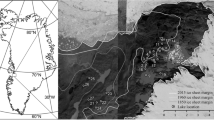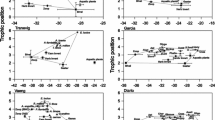Abstract
Although theoretical foodweb models predict the presence of only three to four trophic categories, estimation of “potential” vertical foodweb structure from species lists and inferred feeding interactions suggest that as many as 7 trophic categories can occur in the pelagic foodwebs of North American glaciated lakes. A compilation of data on the nitrogen isotopic composition of zooplankton from 46 Canadian Shield lakes suggested the average existence of one “realized” trophic category in addition to that of filter-feeding, herbivorous cladocerans. When phytoplankton, planktivorous invertebrates, and plantivorous and piscivorous fish are included, the vertical foodweb structure in the pelagic zones of these lakes are greater than those hypothesized from some theoretical models.
Similar content being viewed by others
References
Briand, F. (1983) Environmental control of food web structure.Ecology 64: 253–263.
Cabana, G. and J. B. Rasmussen (1994) Modelling food chain structure and contaminant bioaccumulation using stable nitrogen isotopes.Nature 372: 255–257.
Cabana, G. and J. B. Rasmussen (1996) Comparing aquatic food chains using nitrogen isotopes.Proceedings of the National Academy of Science of the USA (in press)
Cohen, J. E., F. Briand and C. M. Newman (1986) A stochastic theory of community food webs. III. Predicted and observed lengths of food chains.Proceedings of the Royal Society of London Series B 228: 317–353.
Cohen, J. E. and T. Luczak (1992) Trophic levels in community food webs,Evolutionary Ecology 6: 73–89.
Cousins, S. (1980) A trophic continuum derived from plant structure, animal size and a detritus cascade.Journal of Theoretical Biology 82: 607–618.
Cousins, S. (1987) Decline of the trophic level concept.Trends in Ecology and Evolution 2: 312–316.
Darnell, R. M. (1961) Trophic spectrum of an estuarine community, based on studies of Lake Pontchartrain, Lousiana.Ecology 42: 553–568.
del Giorgio, P. A. and R. L. France (1996) Ecosystem-specific patterns in zooplankton and POM or microplankton δ13C.Limnology and Oceanography 41: 359–365.
DeNiro, M. J. and S. Epstein (1981) Influence of diet on the distribution of nitrogen isotopes in animals.Geochimica et Cosmochimica Acta 45: 341–351.
Dillon, P. J. and others (1987)Lakeshore capacity study. Trophic status report. Ontario Ministry of Municipal Affairs, Toronto, Ontario.
France, R. L. (1994) Nitrogen isotopic composition of marine and freshwater invertebrates.Marine Ecology Progress Series 115: 205–207.
France, R. L. (1995a) Differentiation between littoral and pelagic food webs in lakes using stable carbon isotopes.Limnology and Oceanography 40: 1310–1313.
France, R. L. (1995b) Carbon isotopic variability in the composite pelagic foodweb of four oligotrophic lakes: feeding diversity or metabolic fractionations?Journal of Plankton Research 17: 1993–1997.
France, R. L. and R. J. Steedman (1996) Energy provenance for juvenile lake trout in small Canadian Shield lakes shown by stable isotopes.Transactions of the American Fisheries Society 125: 512–518.
France, R., N. Yan, P. Olesiuk, R. Nero, P. del Giorgio and W. Keller (1995) Secondary analysis of zooplanktivorous macroinvertebrates and phytoplankton and water clarity associations.Freshwater Biology 34: 255–261.
Fry, B. (1988) Food web structure on Georges Bank from stable C, N, and S isotopic composition.Limnology and Oceanography 33: 1187–1190.
Glasser, J. W. (1983) Variation in niche breadth with trophic position: on the disparity between expected and observed species packing.American Naturalist 122: 542–548.
Goldwasser, L. and J. Roughgarden (1993) Construction and analysis of a large Caribbean food web.Ecology 74: 1216–1233.
Gu, B., D. M. Schell and V. Alexander (1994) Stable carbon and nitrogen isotopic analysis of the plankton food web in a subarctic lake.Canadian Journal of Fisheries and Aquatic Sciences 51: 1338–1344.
Hall, S. J. and D. G. Raffaelli (1991) Food web patterns: lessons from a species rich web.Journal of Animal Ecology 60: 823–841.
Hall, S. J. and D. G. Raffaelli (1993) Food webs: theory and reality.Advances in Ecological Research 24: 187–239.
Hamilton, S. K. and W. G. Lewis (1992) Stable carbon and nitrogen isotopes in algae and detritus from the Orinoco River floodplain, Venezuela.Geochimica et Cosmochimica Acta 56: 4237–4246.
Hanski, I. (1987) Plankton that don't obey the rules.Trends in Ecology and Evolution 2: 350–351.
Hecky, R. E. and R. H. Hesslein (1995) Contributions of benthic algae to lake food webs as revealed by stable isotope analysis.Journal of the North American Benthological Society 14: 631–653.
Hobson, K. A. and H. E. Welch (1995) Cannibalism and trophic structure in a high Arctic lake: insights from stable-isotope analysis.Canadian Journal of Fisheries and Aquatic Sciences 52: 1195–1201.
Kercher, J. R. and H. H. Shugart (1975) Trophic structure, effective trophic position, and connectivity in food webs.American Naturlist 109: 191–206.
Kitching, R. L. (1987) Spatial and temporal variation in food webs in water-filled treeholes.Oikos 48: 280–288.
Kling, G. W., B. Fry and W. J. O'Brien (1992) Stable isotopes and planktonic trophic structure in arctic lakes.Ecology 73: 561–566.
Kozlovsky, D. G. (1968) A critical evaluation of the trophic level concept. I. Ecological efficiencies.Ecology 49: 48–60.
Lawton, J. H. (1992) Feeble links in food webs.Nature 355: 19–20.
Levine, S. (1980) Several measures of trophic structure applicable to complex food webs.Journal of Theoretical Biology 83: 195–207.
Martinez, N. D. (1991) Artifacts or attributes? effects of resolution on the Little Rock Lake food web.Ecological Monographs 61: 367–392.
May, R. M. (1983) The structure of food webs.Nature 301: 566–568.
Menge, B. and J. Sutherland (1987) Community regulation: variation in disturbance, competition, and predation in relation to environemntal stress and recruitment.American Naturalist 130: 730–757.
Meeuwig, J. and R. H. Peters (1996) Circumventing phosphorus in lake management: a comparison of chlorophyll-a predictions from land-use and phosphorus-loading models.Canadian Journal of Fisheries and Aquatic Sciences (in press)
Minagawa, M. and E. Wada (1984) Stepwise enrichment of15N along food chains: further evidence and the relation between15N and animal age.Geochimica et Cosmochimica Acta 48: 1135–1140.
Murdoch, W. W. (1966) Community structure, population control, and competition—a critique.American Naturalist 100: 219–226.
Owens, N. J. P. (1987) Natural variations in15N in the marine environment.Advances in Marine Biology 24: 389–451.
Paine, R. T. (1980) Food webs: linkage, interaction strength and community infrastructure.Journal of Animal Ecology 49: 667–685.
Paine, R. T. (1988) Food webs: road maps of interactions or grist for theoretical development.Ecology 69: 1648–1654.
Paine, R. T. (1992) Food-web analysis through field measurement of per capita interaction strength.Nature 355: 73–75.
Peters, R. H. (1977) The unpredictable problems of trophodynamics.Environmental Biology of Fishes 2: 97–101.
Peters, R. H. (1988) Some general problems for ecology illustrated by food web theory.Ecology 69: 1673–1676.
Pimm, S. L. (1980) Properties of food webs.Ecology 61: 219–225.
Pimm, S. L. (1982)Food webs. Chapman & Hall, New York.
Pimm, S. L. and R. L. Kitching (1988) Food web patterns: trival flows or the basis of an active research program.Ecology 69: 1669–1672.
Pimm, S. L. and J. H. Lawton (1977) Number of trophic levels in ecological communities.Nature 268: 329–331.
Pimm, S. L. and J. H. Lawton (1978) On feeding on more than one trophic level.Nature 275: 542–544.
Pimm, S. L., J. H. Lawton and J. E. Cohen (1991) Food web patterns and their consequences.Nature 350: 669–674.
Polis, G. A. (1991) Complex trophic interactions in deserts: an empirical critique of food web theory.American Naturalist 138: 123–155.
Rigler, F. H. (1975) The concept of energy flow and nutrient flow between trophic levels. pp. 15–26.in W. H. Dobben and R. H. Lowe-McConnell (eds.)Unifying concepts in ecology. Junk, the Hague.
Saunders, P. T. (1978) Population dynamics and the length of food chains.Nature 272: 189–190.
Sprules, W. G. and J. E. Bowerman (1988) Omnivory and food chain length in zooplankton food webs.Ecology 69: 418–426.
Vander Zanden, M. J. and J. B. Rasmussen (1996) A trophic position model of pelagic food webs: impact on contaminant bioaccumulation in lake trout.Ecological Monographs (in press).
Wada, E., M. Terazaki, Y. Kabaya and T. Nemoto (1987)15N and13C abundances in the Antarctic Ocean with emphasis on the biogeochemcial structure of the food web.Deep-Sea Research 34: 829–841.
Wada, E., Y. Kabaya and Y. Kurihara (1994) Stable isotope structure of aquatic ecosystems.Journal of Bioscience 18: 483–499.
Warren, P. H. (1995) Estimating morphologically determined connectance and structure for food webs of freshwater invertebrates.Freshwater Biology 33: 213–221.
Winemiller, K. O. (1990) Spatial and temporal variation in tropical fish trophic networks.Ecological Monographs 60: 331–367.
Yoshioka, T., E. Wada and H. Hayashi (1994) A stable isotope study on seasonal food web dynamics in a eutrophic lake.Ecology 75: 835–846.
Yodzis, P. (1981) The stability of real ecosystems.Nature 289: 674–676.
Yodzis, P. (1984) Energy flow and the vertical structure of real ecosystems.Oecologia 65: 86–88.
Author information
Authors and Affiliations
Rights and permissions
About this article
Cite this article
France, R., Westcott, K., del Giorgio, P. et al. Vertical foodweb structure of freshwater zooplankton assemblages estimated by stable nitrogen isotopes. Res Popul Ecol 38, 283–287 (1996). https://doi.org/10.1007/BF02515738
Received:
Accepted:
Issue Date:
DOI: https://doi.org/10.1007/BF02515738




